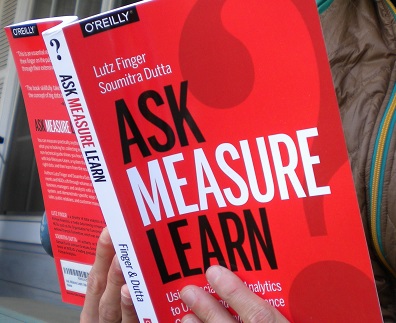Your cart is currently empty!

Finger & Dutta: “Ask, Measure, Learn”
“Likes don’t create revenue,” an article a client sent to us today concluded, “new clients create revenue.” They were making an excellent point. “If you decide to use outside social media firms,” they said, “make sure that you focus them on getting results (leads) and not ‘likes’ or ‘impressions.’”
But it’s actually not always that simple, and there’s where Ask, Measure, Learn comes in. This book helps you determine what questions to ask about social media metrics, and how to find the answers.
Chapters examine the primary business uses of social media:
- marketing
- sales
- public relations
- customer care
- market research
Each chapter gives examples of this usage, from case studies of major companies to personal experiences. There is also a lot of discussion of specific issues for each usage. For example, the chapter on using social media for sales discusses the common path to purchase, signs of intent to buy, reach vs. intent to purchase, and tools like online reviews and recommendation engines.
There is a lot of valuable discussion of how particular kinds of data can be manipulated, and how to take this into account in setting up your particular social media metrics and scorecards. There is in fact a whole chapter on “Gaming the System” which looks at everything from why buying followers doesn’t actually help politicians to suggestions for how to identify your organizations vulnerabilities to social media hacking.
The book concludes with a how-to section that can help you get from your organization’s goals to measurement and improvement. There is some interesting discussion of ROI in particular, and of why it is so difficult to measure the ROI of social media. It seems to me that part of the problem here is that social media is enough more measurable than traditional advertising that we feel as though it ought to be possible to calculate the ROI accurately, even though we don’t attempt to calculate the ROI of, say, having conversations with people or answering the company phone in a friendly way.
We’ve seen this lead to metrics that verge on the bizarre. One of my favorites is the company that searches for mentions of clients in a highly unnatural phrase as a “before” measurement, pays people to use that phrase in social media, and then triumphantly presents the client with the increase of the use of that phrase. If you run into this, reading Ask, Measure, Learn will help you recognize that they are blowing smoke up your skirt.
Finally, the authors suggest discussing your choices of metrics with other people to get a little common sense indication of whether your chosen metrics might be misleading. “A good indication” of misleading metrics, they suggest, “could be any sentence that starts with ‘this is stupid’ or ‘this is just not true.’”
If you’re interested in social media and serious about choosing the right metrics, this book should interest you. It’s not light reading and it’s not a step by step guide. The authors are asking people to join them in the discussion of how best to measure social media’s use and value, certainly a worthwhile discussion, so consider joining in at Twitter with @askmeasurelearn (as of this writing, this Twitter account is not yet live, so check back in future).
I received a copy of this book for review. I was not paid for this review, and you know I always tell you the truth.
by
Tags:

Leave a Reply